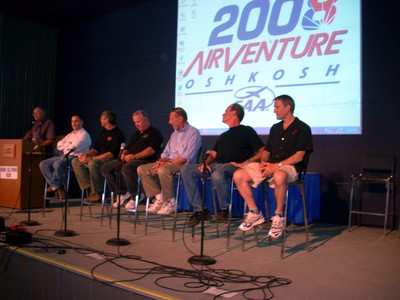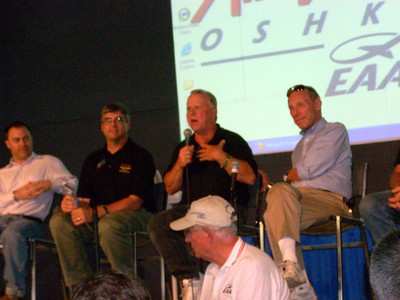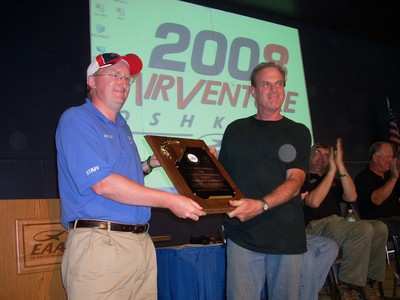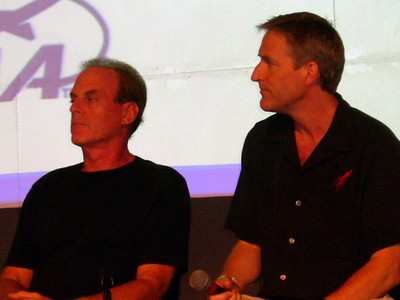EAA Developing Prize To Promote Innovation, Competition For
Electric LSA
by ANN Correspondent Maxine Scheer
AirVenture attendees packed into Forum 7 Thursday afternoon to
hear an expert panel talk about progress in developing electric
aircraft. Panelists included David Palombo, with AVEOX, an expert
on brushless electric motors and controllers, Pete Buck and John
Monnett of Sonex, Dr. Morton Grosser, an independent Director,
technology consultant and venture capital investor in Silicon
Valley, Randy Fishman, President of Electric Aircraft Corp., and
Erik Lindbergh, a commercial pilot, flight instructor, and grandson
of Charles and Anne Lindbergh. The panel was led by Craig Willen, a
Lifetime member of EAA and committee representative leading EAA's
Electric Aircraft initiatives.

Craig opened the event with a description of the growing
interest and impetus behind the development of a highly efficient,
electrically-powered aircraft. He delved into a description of the
very serious issues that aviators could face if the industry
continues to rely on existing fossil fuels and the significant
impacts to aviation freedom that could occur if the price and
supply conditions continued on their current trends.
He described a number of initiatives that the panelists were
undertaking in developing an LSA application for an electrically
powered aircraft and identified them as "just the beginning". The
development of electrically powered aircraft will happen", said
Willen, "and will change the way we move through the environment.
It could be the greatest challenge in aviation history."

As reported by ANN in April, at the close of
the 2008 Electric Aircraft Symposium in San Francisco, EAA's Craig
Willen announced a significant advocacy measure by EAA, a request
to the FAA for regulatory exemptions that would allow the use of
electric motors in ultralight and light-sport aircraft.
"Our goal", said Craig, "is to engage as many EAA members [as
possible] in workshops and competitions. The ultimate goal
described as having tens of thousands of electrically powered
aircraft. Willen was enthusiastic about an EAA initiative that
began development in 2007, in which a "significant" challenge prize
would be offered by EAA for an electrically powered LSA that met
specific and rigorous performance targets.
David Palombo was asked about the state of the art in an
electric aircraft power plant and described what was essentially a
very simple 40HP engine that weighed an impressively light 18
pounds and had essentially 1 moving part. In his (and other
panelists') estimation, electric engines are three-times more
efficient than an internal combustion engine. "The bigger
challenge, said Palombo, "is having to rethink the aircraft
structure and essentially design the airframe around the engine."
This point was repeated throughout the comments made by many of the
forums participants.

John Monnett of Sonex, commented that "the integration of the
electrical system was realistically years away". He estimated that
to power an LSA, an electric motor in excess of 55KW would need to
be developed. Monnett maintains a longer-term perspective on the
development of electric aircraft. "It's closely held, proprietary
knowledge", said Monnett, "we have to go through the gates
ourselves". Sonex's efforts have resulted thus far in the
Sonex Aircraft, LLC E-Flight Initiative proof-of-concept
electric-powered Waiex. The aircraft is on display in the EAA
Welcome Center during EAA AirVenture Oshkosh 2008.
The panelists spoke to issues beyond the technical challenges
associated with the design of an electric aircraft. "History has
shown that any large change in the source of energy was a prime
mover and created a major change in civilization", said Dr.
Grosser. He sees the development of electrically powered aircraft
in the same category as the invention of the automobile. "There are
currently 12 electrically powered aircraft", said Grosser, "so it
is possible that in less than 5 years the industry will have a
scalable model, using the technology that already exists today."
Grosser reported that extensive research is being done in
nanotechnology and is being applied to battery power.

"My grandfather would likely be somewhat panicked to see the
lack of options we have in aviation today," said Erik Lindbergh,
who expressed his appreciation for the innovators of electric power
who foresaw the need for alternative sources of power. "I don't
care if the aircraft looks different", said Lindbergh, "I want my
son to have the freedom it represents." Erik is one of the founders
of X-Prize and serves as a Trustee; he sees the prize model well
applied to the development of electric aircraft.
Randy Fishman was asked about specifics on the ElectraFlyer-C,
which is on display at Aero-Shell Square. The ElectraFlyer-C has an
18 HP engine and the longest flight, thus far, has been 5 hours.
The aircraft is also being developed with a regeneration function,
said Fishman. He was promised by Craig Willen that he would have a
chance to fly before the end of AirVenture 2008.
Fishman previously flew an electric-powered weight-shift trike
at EAA AirVenture Oshkosh 2007, for which he won grand champion
ultralight and outstanding innovation awards. Fishman continues to
receive recognition for his accomplishments. At the close of
today's forum, Adam Smith of EAA presented to Randy Fishman, the
2008 EAA August Raspet Award for Innovation.

There was not much time allowed at the forum for audience
questions, so Craig Willen suggested that attendees check in with
EAA website where a Q&A forum on the subject of electric
aircraft would be developed.
 Aero-News: Quote of the Day (04.28.25)
Aero-News: Quote of the Day (04.28.25) ANN's Daily Aero-Term (04.28.25): Decision Altitude (DA)
ANN's Daily Aero-Term (04.28.25): Decision Altitude (DA) ANN's Daily Aero-Linx (04.28.25)
ANN's Daily Aero-Linx (04.28.25) Airborne-Flight Training 04.24.25: GA Refocused, Seminole/Epic, WestJet v TFWP
Airborne-Flight Training 04.24.25: GA Refocused, Seminole/Epic, WestJet v TFWP Aero-News: Quote of the Day (04.29.25)
Aero-News: Quote of the Day (04.29.25)







